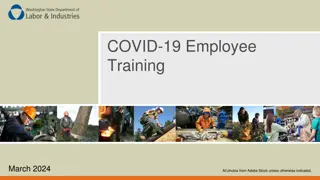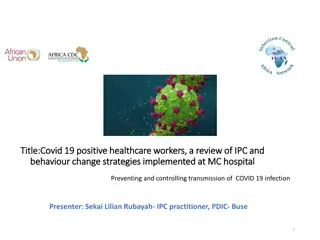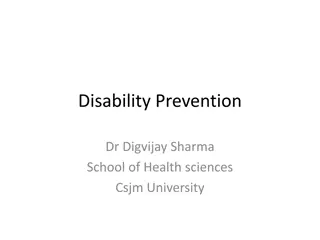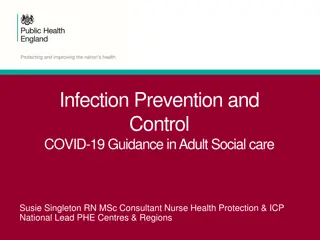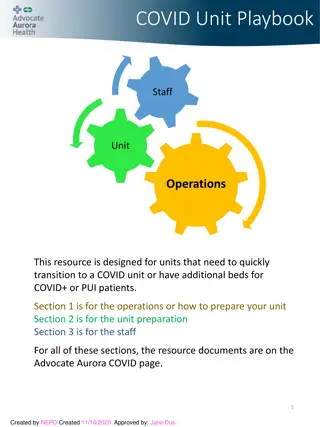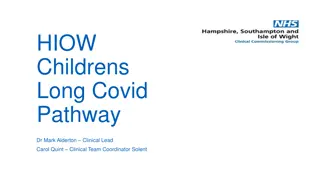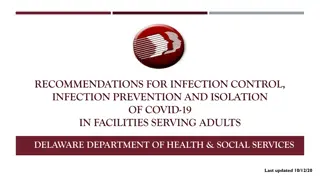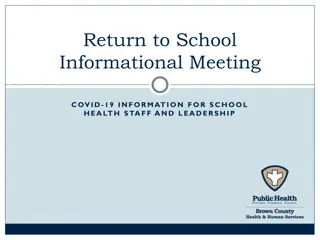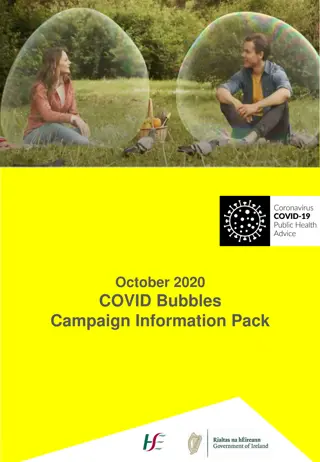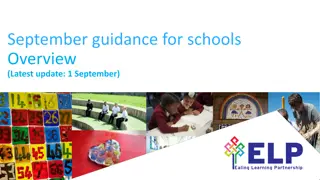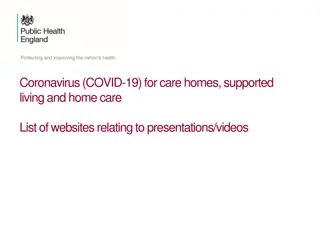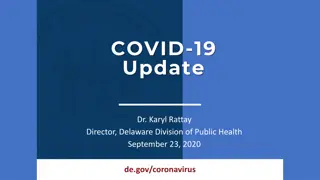COVID-19 School Guidance and Prevention Measures
This content provides guidance for school administration and nurses on handling COVID-19 in schools. It covers essential information on COVID-19 background, prevention measures, cleaning and disinfecting protocols, and key definitions like close contact and face coverings. The guidance emphasizes the importance of wearing face coverings, hand washing, maintaining physical distance, cleaning high-touch surfaces, and limiting gatherings to prevent the spread of the virus. It also includes detailed cleaning procedures and definitions crucial for managing COVID-19 in school settings.
Download Presentation

Please find below an Image/Link to download the presentation.
The content on the website is provided AS IS for your information and personal use only. It may not be sold, licensed, or shared on other websites without obtaining consent from the author.If you encounter any issues during the download, it is possible that the publisher has removed the file from their server.
You are allowed to download the files provided on this website for personal or commercial use, subject to the condition that they are used lawfully. All files are the property of their respective owners.
The content on the website is provided AS IS for your information and personal use only. It may not be sold, licensed, or shared on other websites without obtaining consent from the author.
E N D
Presentation Transcript
COVID COVID- -19 School Guidance School Guidance 19 For School Administration and Nurses Presented by Sedgwick County Health Department November 9, 2020
COVID COVID- -19 Background 19 Background Anyone can become infected with SARS Anyone can become infected with SARS- -CoV CoV- -2 2 There is no vaccine at this time There is no vaccine at this time COVID COVID- -19 symptoms are similar to other 19 symptoms are similar to other conditions/illnesses like influenza (flu) conditions/illnesses like influenza (flu) COVID COVID- -19 spreads through respiratory droplets 19 spreads through respiratory droplets Still learning about this new virus Still learning about this new virus 2
Prevention Measures Prevention Measures Wearing a face covering Wearing a face covering Washing hands Washing hands Keeping six Keeping six- -feet distance feet distance Cleaning and disinfecting surfaces Cleaning and disinfecting surfaces Limiting gatherings of people Limiting gatherings of people 3
Cleaning and Disinfecting Cleaning and Disinfecting 1. 1. Clean high Clean high- -touch surfaces and objects in the classroom using soap or touch surfaces and objects in the classroom using soap or detergent and water to physically remove germs, dirt and impurities. detergent and water to physically remove germs, dirt and impurities. 2. 2. Disinfect high Disinfect high- -touch, meeting Environmental Protection Agency (EPA) criteria for use against meeting Environmental Protection Agency (EPA) criteria for use against SARS SARS- -CoV CoV- -2 and use according to the manufacturer s instructions. 2 and use according to the manufacturer s instructions. touch, cleaned cleaned surfaces in the classroom with products surfaces in the classroom with products 3. 3. If materials are used by multiple people If materials are used by multiple people disinfect between shared use. use. disinfect between shared 4. 4. Conduct targeted and more frequent cleaning and disinfecting of high Conduct targeted and more frequent cleaning and disinfecting of high- - touch surfaces of shared spaces (e.g., tables and chairs, railings, door touch surfaces of shared spaces (e.g., tables and chairs, railings, door handles). handles). 4
Definitions Definitions Close Contact: Close Contact: A person who has been within six feet, for ten minutes or longer to a person who tested positive for COVID-19 while he/she was infected (as per KDHE). Face Covering: Face Covering: A covering of the nose and mouth that is secured to the head, or wrapped around the lower face. - Face shields are not a substitute for cloth face coverings and should only be worn if a person cannot wear a face covering - If face shields are used without a mask, they should wrap around the sides of the wearer s face and extend to below the chin Self Self- -Isolation: Isolation: The separation of people with COVID-19 from others who are not infected during the time when the person with COVID-19 is infectious. This prevents disease spread. 5
Definitions Definitions Self Self- -Quarantine: Quarantine: The separation of a person who has been exposed to COVID-19 from others who are not exposed until the time when the person could develop symptoms or be infectious. This prevents disease spread. In In- -home self home self- -quarantine from the rest of the household for 14 days from the last exposure to a positive case. - Stays home 24/7 unless a doctor appointment, does not attend school or public activities In In- -school self school self- -quarantine quarantine, a person stays in a classroom and enters and leaves at times when few people could be exposed for 14 days from last exposure to a positive case. - Stays at home when not in school, does not attend public activities quarantine, a person stays at home in a separate place 6
Procedures Procedures and and Scenarios Scenarios 7
Student or Staff TESTS POSITIVE TESTS POSITIVE 1. 1. After learning of a positive test, the school nurse/principal/designee will After learning of a positive test, the school nurse/principal/designee will gather the following information: gather the following information: a. Contact information and birth date of the person who tested positive b. Date of test and location where the person was tested 2. School nurse/principal/designee will report it to SCHD via one of the 2. School nurse/principal/designee will report it to SCHD via one of the following methods: following methods: a. Online Electronic Notice Disease Reporting Form https://www.sedgwickcounty.org/health/report-a-disease/ b. SCHD Epidemiology Hotline (316-660-5555; press 1 and 1 again to reach someone immediately) c. Fax completed Kansas Notifiable Disease Form to 24-hour line (316-660-5550) 8
Student or Staff TESTS POSITIVE TESTS POSITIVE 3. SCHD verifies the report before contacting the school. 3. SCHD verifies the report before contacting the school. - SCHD receives COVID-19 test results from laboratories of all people tested in Sedgwick County and may receive a notice of a positive test before the school does 4. If the positive test result is verified, 4. If the positive test result is verified, a person that tests positive should self a person that tests positive should self- - isolate at home. isolate at home. He/She should stay home for 72 hours He/She should stay home for 72 hours after subsided OR 10 days from the day symptoms started subsided OR 10 days from the day symptoms started whichever period is longer. longer. after symptoms have symptoms have whichever period is - SCHD interviews the person (symptoms, exposure, close contacts, where they have been while infectious). Contacts have a choice to disclose non-school contacts. If person infections at school, SCHD contacts the school nurse to determine close contacts If person not infectious at school, SCHD notifies school nurse of no exposure at school. - - 9
Student or Staff TESTS POSITIVE TESTS POSITIVE 5. If there was exposure at the school, 5. If there was exposure at the school, the school or SCHD will notify all close contacts notify all close contactsof the person who tested positive for of the person who tested positive for COVID COVID- -19. 19. the school or SCHD will 6. It is recommended the school clean and disinfect the areas 6. It is recommended the school clean and disinfect the areas where the person worked. where the person worked. 7. After consulting with school nurse and administrator, SCHD or 7. After consulting with school nurse and administrator, SCHD or the school may send letters to all parents and guardians or to the school may send letters to all parents and guardians or to the parents and guardians of students within the particular the parents and guardians of students within the particular classroom or school area where the exposure took place. classroom or school area where the exposure took place. 10
Student or Staff TESTS POSITIVE TESTS POSITIVE 8. It is recommended the school nurse and administration discuss 8. It is recommended the school nurse and administration discuss the particular situation with SCHD to decide potential next steps, if the particular situation with SCHD to decide potential next steps, if any, that could occur to help reduce the spread. any, that could occur to help reduce the spread. 9. Student/Staff who tested positive can request that SCHD provide 9. Student/Staff who tested positive can request that SCHD provide a return a return- -to to- -school/work letter by: school/work letter by: - Asking the Disease Investigator during a follow-up call - Emailing COVID-19@Sedgwick.gov - Calling SCHD at 316-660-7300 10. Student/Staff who tested positive shall 10. Student/Staff who tested positive shallnot be identified school or SCHD. school or SCHD. not be identified by the by the - This is protected health information 11
Student or Staff IS SICK HAS COVID HAS COVID- -19 Symptoms 19 Symptoms IS SICK or 1. If symptoms are severe, call 9 1. If symptoms are severe, call 9- -1 1- -1 1 Severe symptoms include: Severe symptoms include: - Chest pain/pressure - Severe shortness of breath (only able to say a word or two before taking a breath) - Passing out - Losing consciousness - Confusion (disoriented, unable to remember name, day, date) 2. The student or staff member 2. The student or staff membershould be at home and should get tested. get tested. - Testing can be performed by healthcare provider or SCHD by dialing 316-660-1022 should be at home and should 12
Student or Staff IS SICK HAS HAS COVID-19 Symptoms IS SICK or 3. It is recommended the school clean and disinfect the areas 3. It is recommended the school clean and disinfect the areas where the person worked. where the person worked. 4. If the COVID 4. If the COVID- -19 test is negative, 19 test is negative, the person should stay home until he/she feels better AND is fever-free for 24 hours without the help of fever-reducing medication. . 5. If test is positive, 5. If test is positive, the person who tested positive should stay the person who tested positive should stay home for 72 hours home for 72 hoursafter symptoms have subsided OR ten days from the day symptoms started whichever period is longer. . 13
Student or Staff IS SICK HAS HAS COVID-19 Symptoms IS SICK or 6. If student/staff has no testing performed and has symptoms, 6. If student/staff has no testing performed and has symptoms, the person should stay home for the longer period of either: the person should stay home for the longer period of either: - 72 hours after symptoms have subsided OR - 10 days from the day symptoms started 7. If student/staff tests positive and has no symptoms: 7. If student/staff tests positive and has no symptoms: - The person should self-isolate at home for 10 days after the day they were sampled 8. The school nurse and administration should discuss the 8. The school nurse and administration should discuss the situation with SCHD to decide next steps. situation with SCHD to decide next steps. 14
Staff member IS IS a CLOSE CONTACT of a person AT A SCHOOL AT A SCHOOL CLOSE CONTACT 1. 1. School personnel who are close contacts should stay home School personnel who are close contacts should stay home or can be at school if able to stay away from others (see or can be at school if able to stay away from others (see below and next slides). This is done below and next slides). This is done whether or not they were wearing a mask wearing a maskat the time of exposure to a person who at the time of exposure to a person who tested positive. tested positive. whether or not they were 2. 2. In In- -school self school self- -quarantine is at the discretion of the school. quarantine is at the discretion of the school. - A staff member close contact can remain at school if he/she was: 1. Wearing a mask Wearing a mask 2. Does NOT NOT have COVID-19 symptoms 15
Staff member IS of a person AT A SCHOOL IS a CLOSE CONTACT CLOSE CONTACT AT A SCHOOL 3. Alternatively, Alternatively, schools can decide schools can decide to not allow who are close contacts to physically work within the schools and such members should stay home for 14 days. to not allow staff members 4. A close contact should not attend gatherings A close contact should not attend gatherings or go to any school function or activity outside of school that involves interaction with people. 5. If a close contact is unable to perform all the disease control If a close contact is unable to perform all the disease control steps steps he he/ /she should be at home for 14 days she should be at home for 14 days from last exposure to a person who tested positive. See disease control steps on next slide. 16
Disease Control Steps for Staff who are Disease Control Steps for Staff who are Close Contacts and Working at School Close Contacts and Working at School A close contact at school SHOULD do each of the following A close contact at school SHOULD do each of the following: : 1. Stay six feet from others at all times 2. Wear a face covering at all times Wear a face covering at all times 3. Wash hands often 4. Disinfect frequently touched surfaces 5. Symptom and temperature check temperature check, by the school,prior to start of the school day - Ideally, checks should happen before the person enters the school - 99.0 degrees F or higher should receive a more accurate check and in- depth symptom check 17
Disease Control Steps for Staff who are Disease Control Steps for Staff who are Close Contacts and Working at School Close Contacts and Working at School 6. Check in with medical staff periodically - If symptoms develop, he/she should be sent home immediately If symptoms develop, he/she should be sent home immediately 7. Arrive and leave at different times Arrive and leave at different times than others - Does not commute to school with anyone that is not also a close contact 8. Be physically separated from others for the entire school day 9. Have their own designated bathroom with other close contacts 10. Remain home while not at school 18
Student /Staff IS of a COVID COVID- -19 IS a CLOSE CONTACT CLOSE CONTACT 19 positive person NOT AT SCHOOL NOT AT SCHOOL *The person who tested positive could be a family member or other person who does not attend the school Student/staff who is the close contact Student/staff who is the close contact should be at home for 14 days should be at home for 14 days from the date of last exposure to the person who tested of last exposure to the person who tested positive. positive. from the date 19
Student /Staff is a HOUSEHOLD CLOSE HOUSEHOLD CLOSE CONTACT CONTACT of an asymptomatic COVID-19 positive person who is NOT AT SCHOOL NOT AT SCHOOL *The person who tested positive could be a family member or other person who does not attend the school Student/staff who is the household close contact Student/staff who is the household close contact should be at home should be at home for the 10 for the 10- -day isolation period of the person who tested positive the person who tested positive plus an additional 14 14- -day period day period to ensure not infectious. to ensure not infectious. day isolation period of plus an additional Contact the Health Department to discuss if it is possible to minimize the time. 20
Student /Staff REPORTS BEING TESTED REPORTS BEING TESTED for COVID for COVID- -19, IS NOT 19, IS NOT a CLOSE CONTACT and has NO SYMPTOMS NO SYMPTOMS CLOSE CONTACT 1. 1. With no symptoms With no symptoms, , the student or staff member can be at the student or staff member can be at school until test results come back. school until test results come back. He/She He/She should: and monitor for symptoms. should: Wear a face mask, socially distance, wash hands often, 2. If test results are negative, the healthcare provider shall notify 2. If test results are negative, the healthcare provider shall notify the person. the person. 3. If test results are positive, SCHD notifies the person and 3. If test results are positive, SCHD notifies the person and begins a disease investigation. begins a disease investigation. - The person stays home for 72 hours after symptoms have subsided OR ten days from the day symptoms started whichever period is longer. - The school nurse and administration will discuss the situation with SCHD to decide next steps. 21
Student or Staff MEETS CRITERIA MEETS CRITERIA for TRAVEL TRAVEL and EXPOSURE RELATED EXPOSURE RELATED ISOLATION ISOLATION and QUARANTINE QUARANTINE 1. Travel and Exposure Related Isolation/Quarantine 1. Travel and Exposure Related Isolation/Quarantine Guidelines as determined by KDHE: Guidelines as determined by KDHE: https://www.coronavirus.kdheks.gov 2. Student/staff member meeting criteria for travel 2. Student/staff member meeting criteria for travel SHOULD BE AT HOME FOR 14 CONTINUOUS DAYS SHOULD BE AT HOME FOR 14 CONTINUOUS DAYS AFTER RETURNING TO SEDGWICK COUNTY. RETURNING TO SEDGWICK COUNTY. AFTER 22
When NOT in Quarantine When NOT in Quarantine Students/Staff can be at school when: Students/Staff can be at school when: They are NOT a CLOSE CONTACT NOT a CLOSE CONTACT to a person who tested positive They are a CLOSE CONTACT CLOSE CONTACT of a person who is who is being tested being tested They have been tested but have NO symptoms tested but have NO symptoms and not a close contact 23
When NOT in Quarantine When NOT in Quarantine To illustrate: To illustrate: Bob has no symptoms and has been contacted by SCHD to stay home and self-quarantine. He is at home because his wife Susan has symptoms and has tested positive for COVID-19. She stays home in a room separate from Bob s. Bob s close contacts are not at home in quarantine unless he develops symptoms AND AND tests positive for COVID-19. 24
Sedgwick County Health Department Sedgwick County Health Department https://www.sedgwickcounty.org/ Kansas Department of Health Kansas Department of Health and Environment and Environment https://www.coronavirus.kdheks.gov/ 25
Amanda Bustamante COVID COVID- -19 Outreach Specialist 19 Outreach Specialist Sedgwick County Health Department Amanda.Bustamante@sedgwick.gov Amanda.Bustamante@sedgwick.gov 26



